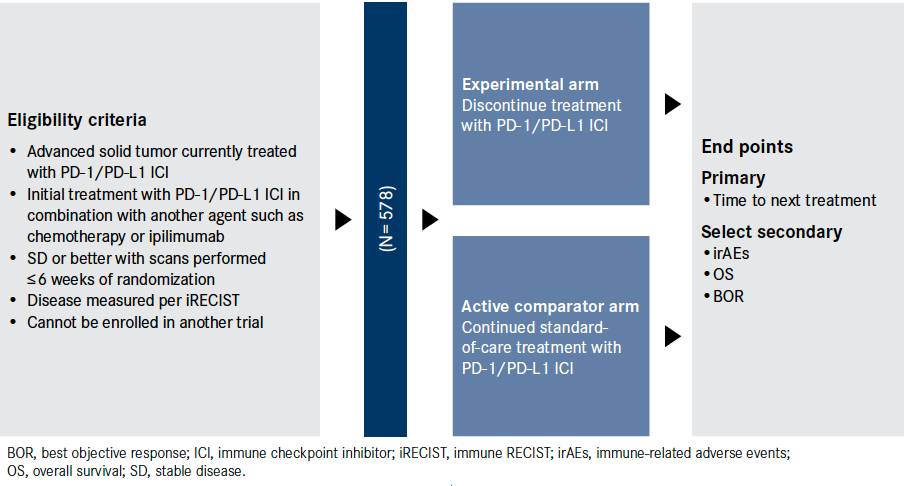Publication
Article
UPMC Trial Explores Optimal Duration of Checkpoint Immunotherapy
Author(s):
Investigators at UPMC Hillman Cancer Center in Pittsburgh, Pennsylvania, have launched a clinical trial to determine the impact on patient outcomes of stopping therapy after 1 year.
Antoinette Wozniak, MD

Although PD-1/PD-L1 immune checkpoint inhibitors (ICIs) have been integrated into the therapeutic landscape of a broad range of solid tumors, the optimal duration for treatment with these agents remains an unanswered question. Investigators at UPMC Hillman Cancer Center in Pittsburgh, Pennsylvania, have launched a clinical trial to determine the impact on patient outcomes of stopping therapy after 1 year.
The phase 3 study (NCT04157985) is randomizing patients treated with ICIs at UPMC Hillman to discontinue or continue therapy after 12 months. Plans call for recruiting 578 patients with advanced solid tumors. To be eligible, patients must have evidence of stable disease (SD) or better on scans performed within 6 weeks of randomization. They also cannot be enrolled in another clinical trial (Figure).1
Figure. Evaluation of Length of Treatment with PD-1/PD-L1 Inhibitor1

The question of how long patients should take ICIs is “one of the great unknowns in oncology right now,” principal investigator Antoinette Wozniak, MD, said in a statement.2 Before starting the study, investigators surveyed 60 medical oncologists in the UPMC network to determine whether they would consider a trial for their patients that would assess the optimal duration of ICI therapy. Fifty-two respondents (86.7%) indicated they would participate.1
“When these drugs came out, patients were treated indefinitely, and some patients had very long benefit. The question that comes up is when is enough treatment enough,” Wozniak said in an interview with OncLive®.
Treatments are generally stopped after 2 years based on findings from recent trials, noted Wozniak, who is associate director for clinical research and director of the Lung Cancer Disease Unit at UPMC Hillman. “But we still don’t know if it is necessary to go out to 2 years. There is not a lot of information that has been published regarding this. We are hoping this will provide more information that could potentially establish the routine length of treatment for these drugs.”
Establishing an optimal length of treatment is important, she said, because of adverse events related to PD-1/PD-L1 inhibitors, as well as the high costs of these therapies.
Patients are being recruited from within the UPMC Hillman network, which sees about 138,000 patients a year at 76 sites throughout Pennsylvania, western New York, Ohio, and western Maryland. Within the UPMC system, about 2300 patients received anti–PD-1/ PD-L1 therapy for a range of advanced solid tumors during 2019.1
Investigators won’t disclose how many patients have been recruited so far, but they indicated the trial is actively recruiting patients with solid tumors such as melanoma, head and neck squamous cell carcinoma, cholangiocarcinoma, hepatocellular carcinoma, and non–small cell lung, bladder, renal, anal, colorectal, and gastric cancers. Wozniak said recruitment has been expanded to encompass patients with Merkel cell and gynecologic tumors.
The trial is accepting patients who are already receiving therapy with the PD-1 inhibitors pembrolizumab (Keytruda) and nivolumab (Opdivo), or the anti–PD-L1 ICIs of atezolizumab (Tecentriq), durvalumab (Imfinzi), or avelumab (Bavencio). Patients who started treatment with any of these ICIs in combination with other therapy, including chemotherapy or the anti–CTLA-4 ICI ipilimumab (Yervoy), also are eligible.
The trial will randomize patients who have stable or responding disease to stop treatment with their PD-1/PD-L1 therapy at 1 year or to continue their standard-of-care treatments until disease progression or unacceptable toxicity.
Rationale for Trial Design
The 12-month time frame for stopping therapy was chosen based on data from recent studies, Wozniak said. In the ICIT study (NCT02673970), investigators analyzed outcomes for 185 patients with advanced melanoma who voluntarily discontinued anti-PD-1 therapy with pembrolizumab (n = 167) or nivolumab (n = 18). Participants had undergone ICI therapy for a median duration of 12 months (range, 0.7-43), including 26 patients (14%) who were treated for less than 6 months.3
At the time of treatment discontinuation, 63% of participants had achieved a complete response (CR), 24% had a partial response (PR), 9% had SD, and 4% had no evaluable disease, according to the best overall responses on CT scans.
After a median follow-up of 18 months after ICI therapy was discontinued, 78% of patients remained progression free and 22% experienced recurrence, with a median time to progression of 12 months (range, 2-23). The estimated 1-year and 2-year progression-free survival rates after discontinuation were 90% (95% CI, 85%-94%) and 71% (95% CI, 63%-79%), respectively.
Patients who had achieved a CR before discontinuing therapy had a significantly lower risk of recurrence compared with those who had a PR (P = .002) or SD (P < .001). Notably, 6 of 19 patients (32%) who were retreated with anti–PD-1 therapy at the time of disease progression had an objective response, including 2 CRs (11%) and 4 PRs (21%).
Wozniak said patients who participate in the UPMC Hillman study will be followed indefinitely. “We are also allowing retreatment with immunotherapy. For instance, if a patient stops at 1 year and then regresses, they can be retreated with immunotherapy because that has been shown to be effective in some studies. We are also going to monitor those patients who get retreated,” she said.
The primary end point of the study is the difference between the 2 cohorts in progression-free survival, defined as the time to the next treatment, progression, or death. Secondary outcome measures comprise the incidence of immune-related adverse events, overall survival, and best objective response. The time frame for evaluation is up to 36 months. Additionally, investigators are collecting and banking participant blood samples for potential follow-up investigations.
Tackling Patient Recruitment
Wozniak and her team were concerned initially about whether patients and providers would be willing to participate in a trial where treatment is stopped. Results of the survey of oncologists were reassuring.
Vincent E. Reyes Jr, MD

However, prospective participants also were concerned about disease progression and response if treatment was restarted, Vincent E. Reyes Jr, MD, who helped lead the development of the trial, said in an interview. “That is why we did this in a very deliberate fashion. We started out at a couple of pilot sites within our network to see what would happen when we started to enroll patients and what their reaction would be,” said Reyes, a clinical assistant professor at University of Pittsburgh School of Medicine and assistant medical director at UPMC Hillman. “Patients have declined because they were worried that if they did progress while off immunotherapy, they may not respond [again].”
Reyes believes that patients would likely respond once treatment is restarted, citing experience with tyrosine kinase inhibitors in chronic myeloid leukemia. Studies have established that certain patients with that malignancy who have attained deep molecular responses to therapy can safely stop and restart treatment upon progression.4
Patient enrollment in the trial also has been complicated by the coronavirus disease 2019 (COVID-19) pandemic, which cut recruitment levels by approximately 50%, Wozniak said. “We were able to keep going better than some institutions across the country,” she said. “The problem with [COVID-19] is not over, so it is hard to say what will happen in the next few months.”
To help address the challenge of identifying patients who might be eligible to participate, Oscar C. Marroquin, MD, chief clinical analytics officer at UPMC, and colleagues developed an application that mines billing data and coordinated that information with details from electronic health records. The system alerts clinical research coordinators (CRCs) about patients who might be eligible.
“The system tries to connect the dots from information from billing data to the CRC to the physician,” said Reyes. “This is something we developed internally, and it is the first time we’ve done this for any clinical trial. This tool is not only good for patient identification but also enabled us to understand why patients or physicians were not putting patients on the trial.”
Although Reyes credits the analytics system with helping to accurately identify patients who may qualify for the trial, he acknowledged that study criterion that patients not be enrolled in another trial has made recruitment challenging.
Investigators also believed it was important to engage physicians and other providers prior to the start of the study. Wozniak and Reyes created an educational webinar for stakeholders, clinicians, advanced practice providers, nurses, and CRCs. They also provided talking points so that nurses and physicians would be on the same page when speaking with patients. For example, the team developed a pamphlet for providers about the top 10 questions that they may encounter when discussing this trial with patients.
Investigators also engaged a UPMC patient advocacy group for its input and to learn more about what information is crucial to get across to potential participants.
This model of integration and engagement, along with tools such as the clinical analytics application, can help to move the needle on clinical trial recruitment within an institution, Reyes said. The analytics system can be reconfigured for another clinical trial or multiple clinical trials.
“As private practicing physicians, we know that clinical trials aren’t always the highest priority. But they have to be. This is something we have to get physicians in both community and academic settings to put at the forefront because that is the only way to improve patient care,” he said. “We are trying to bring all the different perspectives to the table to find solutions.”
- Evaluation of the length of treatment with PD-1/PD-L1 inhibitors in patients with advanced solid tumors. National Institutes of Health. Clinicaltrials.gov. Updated December 4, 2019. Accessed August 13, 2020. https://clinicaltrials.gov/ct2/show/NCT04157985#studydesign
- Novel clinical trial at UPMC Hillman Cancer Center seeks to determine optimal treatment length of PD-1/PD-L1 checkpoint inhibitors. News release. UPMC Physician Resources. May 18, 2020. Accessed August 5, 2020. https://www.upmcphysicianresources.com/news/051820-pd1-clinical-trial
- Jansen YJL, Rozeman EA, Mason R, et al. Discontinuation of anti-PD-1 antibody therapy in the absence of disease progression or treatment limiting toxicity: clinical outcomes in advanced melanoma. Ann Oncol. 2019;30(7):1154-1161. doi:10.1093/annonc/mdz110
- Mahon FX. Treatment-free remission in CML: who, how, and why? Hematology Am Soc Hematol Educ Program. 2017(1):102-109. doi:10.1182/asheducation-2017.1.102









